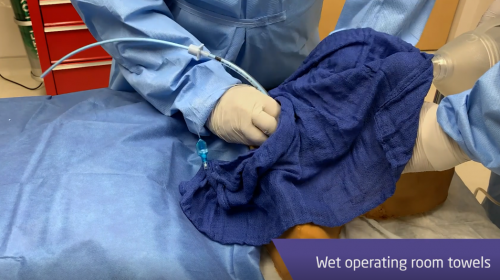COVID-19 has changed everything. Our patients and even our co-workers could be harboring the virus. Workplace precautions have changed. Many of the minutiae of living have changed. All trauma professionals are concerned with protecting themselves from contagion in order to continue providing vital care to more patients.
We have a fairly good understanding of how the virus spreads. Aerosols and aerosolizing procedures are a major risk factor for involved personnel. In general, hospitals already have processes and policies in place for the most common aerosolizing procedure, endotracheal intubation. Even in emergency circumstances, this is a relatively controlled procedure.
But what about cricothyrotomy? This is far less commonly performed, and as such is prone to more variability. Surgeons at Northwestern University in Chicago tested several techniques for more safely performing this procedure. They placed three different types of draping materials commonly found in or around a trauma bay over their hands in an attempt to decrease aerosolization produced during the procedure.
They tested these drapes using a cricothyrotomy simulator based on a porcine trachea. To identify aerosolization, they atomized fluoroscein into the trachea and monitored the procedure with an ultraviolet light.
The first drape tested was a clear plastic x-ray cassette holder. The advantage of using this as a drape is its transparency. The surgeon does not need to peek under the plastic while performing the crich. Unfortunately, the stiffness and slipperiness of the plastic makes it prone to sliding off the procedure site.
A dry blue surgical towel was used next. This performed a bit better, but still slipped off the operative field. Black light inspection showed a significant amount of aerosol contamination of the edge of the towel and the surgeon’s gown.
Finally, a wet blue surgical towel was tested. The towel easily stayed in place and retained nearly all of the aerosolized fluoroscein. There was a negligible amount on the surgeon’s gown.

Bottom line: The authors recommended that wet surgical towels be placed over their hands and used as a barrier when performing a cricothyrotomy in a COVID positive or unknown patient. The reality is that this will apply to this procedure in just about any acute trauma patient you see. Obviously, this trick does not eliminate aerosolization. Rather, it dramatically reduces the amount and hence, the risk to the surgeon and other personnel in the room. It’s not perfect, but definitely worth it!
To view a video demonstrating the technique and results for each of the drapes, click here.
Reference: Emergency cricothyrotomy during the COVID-19 pandemic: how to suppress aerosolization. Trauma Surgery Acute Care Open 5(1):e000482, 2020.
